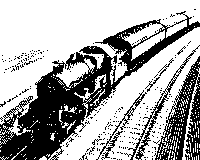

Sam Hallas' Website

| Bits, Bytes and Bauds Booklet BB&B Hardware article |
The booklet to accompany the video "Bits, Bytes & Bauds" and the short article with pictures about the hardware used on the British Rail TOPS system of fleet control. 332 and 78 kB |
| Block Telephone | LNER circuit of Block Bell and Telephone from 1930. Allows dual use of the single wire circuit for block bell and telephone. Courtesy of John Midcalf. See also Fig 185 on P9 of Railway Signalling & Communications, Part 2 below. 38 kB |
| BR 13402 | Code of Practice for railway public address systems. Probably from the early 1950s. Recreation of original. 58kB |
| Development of local telephone facilities on the Southern Region | Some methods of providing automatic telephone systems to stations along low density railway lines. Includes the Line Connector system, Minirax and auto party line. Recreated from the Railway Gazette for 10th May 1963, courtesy of Andrew Emmerson. 450kB |
| Control of Railway Traffic Operation by Telephone and Teleprinter | A technical report prepared in 1945 for the Railways Board of India. Only Part III is included: Design and Operation of Train/ Traffic Control Circuits. Indian Railways used the STC/ Western Electric system. It includes transmission problems, design of telephones and control circuits. Digital recreation: original courtesy of John Goldfinch. 189kB |
| Eastern Region Universal Concentrator Notes and Circuit Description ER Concentrator - Scottish Reg redrawn Card strapping guide Eastern Region 62-type Concentrator |
Set of drawings for the ER design of
concentrator which could be made to terminate almost any
type of telephone line. 23 sheets. Courtesy of Richard Pike.
1.7 MB & 311kB Redrawn version by Scottish Region, 1990. Resized to A-sized paper with extra interfaces. Courtesy Jim Gillies 1.3MB Strapping guide for the line cards 21 kB Design of the systems used at major power signalboxes such as Kings Cross and Peterborough. The control equipment was mounted in Post Office 62-type racking. The controls were built into the signallers' consoles. Courtesy of Andrew Kenning. 51 pp 23 MB |
| Ericsson Bulletins Battery Call Railway Telephones Code Ringing Delay Unit Telephones for Railway Services |
Articles from the Ericsson Bulletin on
railway Telephones. From 1933 about battery calling telephones and the various signalling methods. From 1939 a code ringing delay unit to permit inter-party calls. From 1948 the telephones for railway services developed by Ericsson in response to the railway industry's standard requirements - with circuits and catalogue listing. Photocopy from the Patents Office Library, courtesy of Mike Tyrrell. [Sizes 271 kB, 218 kB, 948 kB] More details on Ericsson telephones can be found at www.britishtelephones.com/ericsson/menut3.htm |
| Ericsson battery call phones diagrams | Cleaned versions of the paster labels for Ericsson N1181, 1182 and 1183 battery call telephones as used widely on British Railways. Courtesy of Bob Freshwater. 276kB |
| Emergency! The role of the telephone | A pocket guide issued to staff explaining the emergency call procedures on the Extension Trunk Dialling internal telephone network and the National Radio Network. 767kB |
| ETD Map Issue L | A map of the BR Extension Trunk Dialling network with numbering scheme from 1981. Last version on tracing film before conversion to CAD. 129kB |
| ETD Map Issue R | As above but Issue R from 1988. The last version ever produced. Note changes in the London area to incorporate the One Number London Exchange Scheme. 400kB |
| ETL Signalbox Concentrator | ETL (later Plessey) signalbox telephone concentrator as widely used on BR Southern Region. Was later manufactured by Whiteley Electronics of Mansfield. Courtesy of Mike Tyrrell. Corrections from Gordon Joyce May 09. 792 kB |
| GEC Systems GEC Control Telephone System GEC Omnibus Telephones GEC Railway Communications Systems |
1. Article from the GEC Journal for May 1931.
The GEC control telephone system allowed selective calling
to telephones on an omnibus system used for railway control.
Courtesy of Mike Tyrrell. 1.3 MB 2. Circuit diagrams of what GEC quaintly called 'Long Distance Railway Sets'. KS 7257 is the standard 2-button widely used on all reagions and KS 13252 is the plastic bodied 4-button especially popular on Eastern Region. From several collections. 716 kB 3. Glossy brochure possibly from the 1980s extolling the virtues of GEC systems for railways worldwide. Some of the pages had fold-out sections, which accounts for the odd format.3.4 MB |
| Hixon Recommendations | Reprint from Railway World October 1970. Modified auto-half barriers are commissioned - The Hixon recommendations are embodied at existing barrier crossings. 190kB |
| L&NWR Telegraph Rules 1905 | London & North Western Railway Telegraph Rules and Regulalations, 1905. General regulations, single needle alphabet, Code time, rules about messages, etc. Courtesy of John Goldfinch. 56pp 1.95 MB |
| LNER Standard Telephone Circuits | LNER standard circuits for Telephone instruments. Courtesy of John Midcalf. 552 kB |
| BR 952 & 953 Omnibus telephones | Specifications BR 952 and 953 circuit diagrams for omnibus battery-calling telephones. BR 952 is for table and wall version with three buttons. BR 953 is a wall-only type and has two variations, 2-button and 4-button. Multiple strapping options are shown for various calling conditions. Courtesy of Adrian Rodsett 127 kB |
| Party Line System with
Selective Ringing |
From ATE Journal 1963. A control telephone
system with a novel selective calling allowing calling
between waystations as well as outward from Control.
Courtesy of Paul Seward. 2 MB |
| PETS Manual PETS Mark II Installation Guide |
Public Emergency Telephone System for use at level crossings. Developed by Whiteley Electronics to a British Rail specification. The installation and user manual was written by Andrew Emmerson as a freelance author, from notes supplied by Steve Radford of Whiteley. The layout and illustration were done by me, Sam Hallas. The later Mark II version had its installation guide produced by Whiteley. 1.2 MB & 2 MB |
| Plessey Post-Hixon AHB System Drawing 20747 Crossing Unit Drawing 20748 Signal Box Unit Drawing 207568 Crossing Phone Complete set of Drawings |
Telephone System for automatic half barriers
at level crossings. Plessey technical manual for the
post-Hixon system.929 kB, A2 sized circuit diagrams marked with modifications post-1980. 290 kB, 284 kB & 28 kB Complete set of drawings courtesy of Andrew Kenning, 6.6MB |
| Railway
Engineering School Brochure Railway Engineering School Notes |
The glossy brochure produced to publicise the Railway Engineering School, Derby and the notes provided to students. Dated 1982. Courtesy of Norman Henderson. 3.8MB and 225kB |
| Racal Belle | Racal Telecomms sponsored the restoration of inspection car, Saloon No 999503. This booklet was issued to commemorate its completion. Courtesy of Mike Tyrrell.1.1MB |
| Railway Signalling and Communications Telephony Part 1 Telephony Part 2 |
A text book produced in the 1930s from Signal
& Telecomms lectures. Chapter XI, Telephony contains: Part 1 - Principles of sound, Transmitters and receivers, Induction coil, Sidetone, Magneto ringing, Switchboards, Automatic system. Part 2 - Traffic Control Systems, Lines, Transposition of Wires, Lightning Protection, Superimposition, Buzzer Telephones, Carrier Telephony. Part 1 265 kB, Part 2 559 kB |
| Railway Telephones | An article by S. Flint from a Newnes part-work about 1934 refers to mainly GEC equipment. Courtesy of Andrew Emmerson Digital recreation. 1.3MB |
| Royal Train 1941 | An article from Railway Magazine, about the 1941 rebuild of the Royal Train saloons for the King and Queen. The installation of a 25-line exchange is noted and one picture shows a Gecophone on a table. Courtesy of Andrew Emmerson 482 kB |
| Single-Needle Circuits | LNER standard circuits for Single-Needle instruments. Courtesy of John Midcalf. 151 kB |
| STC Traffic Control Description STC Traffic Control Revised Edn STC Systems Catalogue 1957 STC Waystation using 746 Bell Telephones Paper to 1925 Congress |
STC Traffic Control Telephone Systems -
Circuit Description and Hints on Maintenance. Full handbook
for the system. Courtesy of Richard Pike. 85 pages 2.2
MB System Description, Design information and circuit descriptions. 40 pages 628 kB Catalogue of STC Railway Systems from 1957. Courtesy of Mike Tyrrell. 27 pages 1.9 MB A waystation designed for Irish P&T using telephone No 746 and Type 60 selector, courtesy of John Mulrane. A paper presented by Bell Telephone Manufacturing Company to the Congress of International Association of Railways in 1925 in London. Description of the system with diagrams and illustrations. In French, courtesy of Remco Enthoven [1.85 MB] |
| STC Selective SPT System | A description of the STC selective signal post telephone system. Describes the signalbox unit and the mechanical waystation telephone.842 kB |
| STC Signal Post Telephone System | Technical handbook for the motorised dialling version of the STC signal post telephone system. Includes diagrams of the signal box interface and carrier circuits. 1.33MB |
| Teleprinter Report | Report by the British Transport Commission special committee into the teleprinter network, April 1954. Digital Recreation. 71 kB |
| Train Wires to the Horizon | Reprint of an article from Railroad Magazine, March 1947. Traces the history of telegraphy and its close association with railways. Particular attention on involvement of Baltimore and Ohio Railroad, who offerd Sam Morse a wayleave for his demonstration. Culminates with report of trial, revolutionary for the time, of FAX transmission to a moving train. (Yes, in 1947!) 646kB |
| Weatherproof 745 type telephone Weatherproof CB Telephone Weatherproof Magneto Telephone |
Plessey Weatherproof CB 745 type telephone -
vandal resistant. Plessey manual including A2 sized drawing.
822kB Weatherproof Magneto (Transistor ringing). Plessey manual includes large drawing.453 kB |
| Weatherproof Telephone Racal RA705 Series RA705/2000 CB Telephone RA705/4000 Autodialler Telephone RA705/2000 CB Telephone - later version |
Racal Acoustics RA705 Series weatherproof
telephone User and Installation guide. Early typescript guide for the 2000 series CB 88 kB Early typescript guide for the 4000 series autodialler 92 kB Later (1987) printed guide for the 2000 series 379 kB |
Repository Index